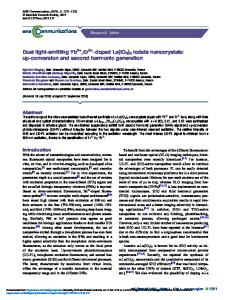Di-Urethane Cross-linked Poly(oxyethylene)/Siloxane Nanohybrids Doped With Eu(CF 3 SO 3 ) 3
- PDF / 143,049 Bytes
- 6 Pages / 612 x 792 pts (letter) Page_size
- 51 Downloads / 288 Views
EE13.1.1
Di-Urethane Cross-linked Poly(oxyethylene)/Siloxane Nanohybrids Doped With Eu(CF3SO3)3 M. C. Gonçalves1, V. de Zea Bermudez1, R. A Sá Ferreira2, D. Ostrovskii3 and L. D. Carlos2 1 Department of Chemistry and CQ-VR, University of Trás-os-Montes and Alto Douro, 5000-911 Vila Real, Portugal 2 Department of Physics and CICECO, University of Aveiro, 3810 -193 Aveiro, Portugal 3 Department of Applied Physics, Chalmers University of Technology, 41296 Göteborg, Sweden ABSTRACT Attractive sol-gel derived di-urethane cross-linked poly(oxyethylene), POE/siloxane hybrids (di-urethanesils) doped with europium triflate, Eu(CF3SO3)3 were examined by Fourier Transform mid-infrared (FT-IR), Raman (FT-Raman) and Photoluminescence spectroscopies with the main goal of elucidating the chemical environment of the cations in these materials. In these hybrids the POE chains contain about 13 oxyethylene repeat units. Samples with compositions ∞ > n ≥ 5 (where n indicates the ratio of (OCH2CH2) moieties per Eu3+ion) were investigated. The FT-IR and FT-Raman data obtained provided unequivocal evidence that the ether oxygen atoms of the polymer chains start to interact with the Eu3+ ions at n = 20. The presence of a crystalline POE/Eu(CF3SO3)3 complex was detected at n ≤ 20. Photoluminescence results demonstrated that the doped di-urethanesils studied here are room temperature (RT) efficient full-color emitters. Two distinct cation local sites were unequivocally identified at n = 200 and 20. These Eu3+ local coordination sites involve the oxygen atoms of the urethane carbonyl groups and weakly coordinated Eu3+/CF3SO3– ionic species. For the most concentrated hybrid (n=5) evidences of a third local-environment probably involving the oxygen atoms of the polymer chains was observed. INTRODUCTION Rare-earth (RE) ion-doped di-urethane cross-linked poly(oxyethylene) (POE)/siloxane hybrid frameworks (di-urethanesils) are materials of the utmost interest for optics, specially for the fabrication of displays and lighting devices [1]. These hybrid systems are good candidates to minimize non-radiative paths, because they are essentially non-hygroscopic and display excellent encapsulating ability towards guest RE ions. In the present work we will employ FT-IR, FT-Raman and Photoluminescence spectroscopies to investigate d-Ut(600)-based (where d denotes di, Ut indicates the urethane (NH(C=O)O-) cross-links and 600 is the average molecular weight of the POE chains in gmol-1) di-urethanesils doped with a wide range of Eu(CF3SO3)3 concentration. The xerogels were identified by the formula d-Ut(600)nEu(CF3SO3)3. The main goal of this study is to get insight into the cation coordination sphere. We must emphasize that there are three available coordinating sites for the cations in these POE/siloxane-type hybrid frameworks: (1) the ether oxygen atoms of the polymer chains, (2) the carbonyl oxygen atoms of the urethane cross-links and (3) the triflate oxygen atoms [2-5]. EXPERIMENTAL DETAILS The synthesis of the d-Ut(600)nEu(CF3SO3)3 di-urethanesils was
Data Loading...











